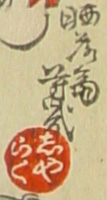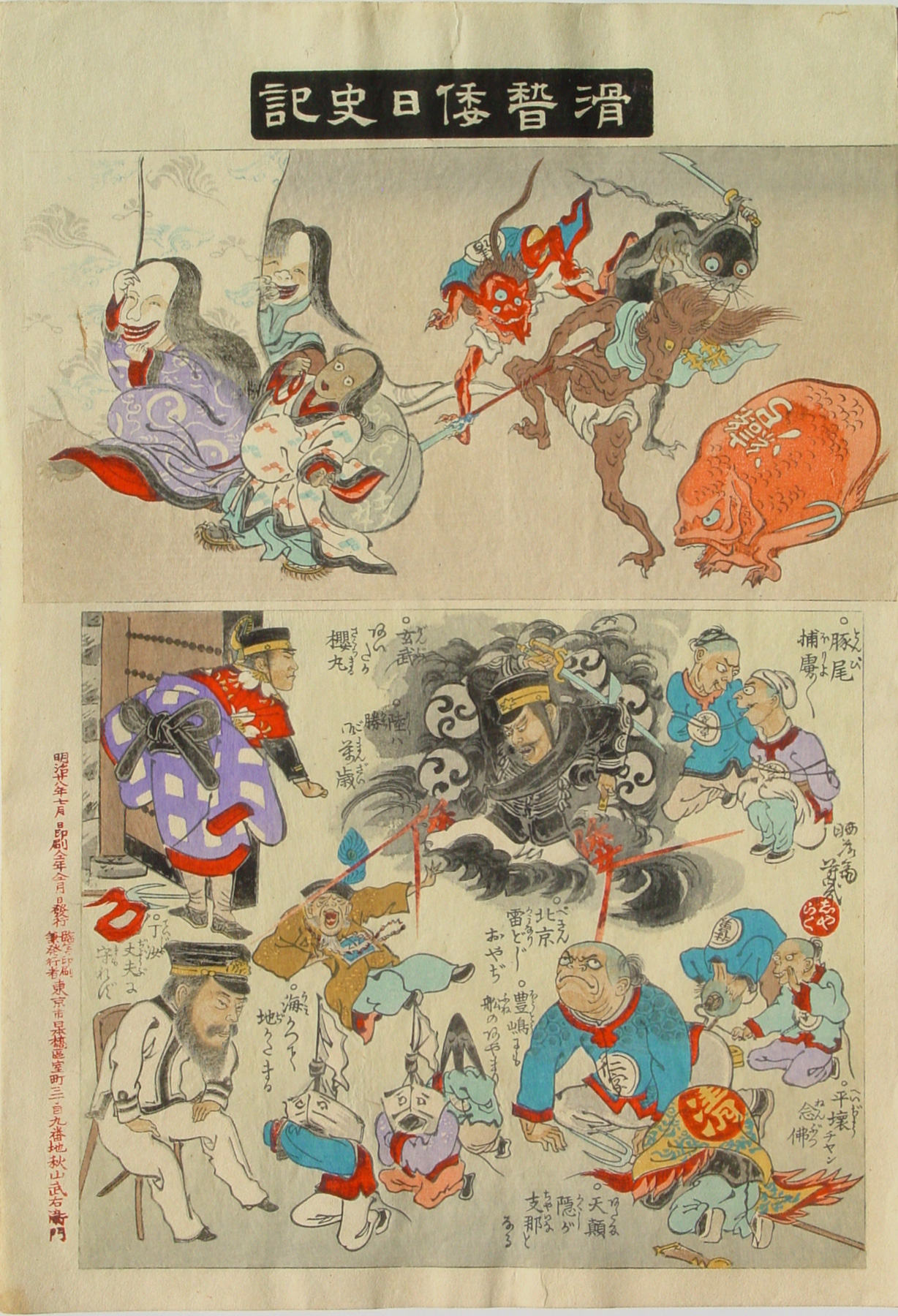About This Print
The Ukiyo’e Caricatures 1842-1905 website1 of the Department of East Asian Studies - Japanese Studies, University of Vienna provides the following transcriptions of the kanji associated with each caricature in the bottom half of the print:
1. Tonbi horyo horyo
2. Genbu aitaka Sakuramaru
3. Riku wa kachi go-banzai
4. Pekin kaminari doji-oyaji
5. Hōtō ni mo fude no ayamari
6. Umi katte ji katamaru
7. Teijo jōbu ni mamorezu
8. Heijō chan nenbutsu
9. Atama kakushite shiri kakusazu
1 University of Vienna http://ukiyoe.univie.ac.at/detail.asp?docid=1442&lang=e&first=1
The Kokkei Yamato Hi shiki is a set of nine woodblock prints comprising two connected groups of cartoons and caricatures, in two registers one above the other. The term Yamato Hi in the main title, which appears with a black rectangular cartouche on the upper margin of each sheet, is an ancient name for Japan that defies direct translation.
All the cartoon images that form the upper half of the joined set, subtitled Shin'an hyakki yakō (Newly Designed Night Parade of One Hundred Ghosts), are of the so-called hundred ghosts from Japanese folk tales. The images that make up the lower half of the set, subtitled Zenshō shukusai shinji andon (Shintō Rituals and Lantern Parade Celebrating Complete Victory), are caricatures of the Sino-Japnese War of 1894-1895, in which the defeated Chinese are mocked and satirized.
The Night Parade of One Hundred Demons
Source: Field Museum websiteThe Night Parade of One Hundred Demons is a theme that has captivated the imagination of Japanese artists for centuries. Since the Heian period (794-1185 AD), and perhaps even earlier, Japanese painters have rendered scenes of demonic creatures romping and cavorting at night. Japanese story tellers say that one night each summer all sorts of terrifying beings make their way to the mountains to enjoy themselves with games and amusements.
The publication by Toriyama Sekien of a book on Hyakki Yakō in 1776 signaled a new interest in the fantastic theme of Night Parade of One Hundred Demons, which was to last throughout the Edo and Meiji periods. Late in the nineteenth century, the printmaker Utagawa Yoshiiku (1833-1904) produced several imaginative illustrations based on the Night Parade of One Hundred Demons. One of these was his Kokkei Wanisshi-ki (Comical Record of Japanese History), which employs the theme of 100 demons to comment on contemporary Japanese military actions in China.
This installation features more than 30 loans from two remarkably rich local resources, the Lavenberg Collection of Japanese Prints, and the Lee & Mary Jean Michels Collection. It was co-curated by Professors Akiko Walley (History of Art and Architecture) and Glynne Walley (East Asian Languages and Literatures) and JSMA Chief Curator Anne Rose Kitagawa. QR codes on selected labels allow visitors to access translations and explanations of the complex wordplay, imagery, and cultural context of these fascinating objects.
UTAGAWAYoshiiku (歌川芳幾,1833-1904)
Japanese;Meiji period, July 1895
Thunder God and Demons, from the series ComicalRecord of Japanese History (Kokkei Yamatoshiki), upper register “Newly Designed Night Parade of a Hundred Demons” (Shin’an hyakki yagyō); lower register“Shintō Rituals and Lantern Parade Celebrating Total Victory” (Zenshō shukusai shinji andon)
Ukiyo-e woodblock print in vertical ōban format; ink and color on paper
The Lavenberg Collection of Japanese Prints,IHL.0248
This installation features more than 30 loans from two remarkably rich local resources, the Lavenberg Collection of Japanese Prints, and the Lee & Mary Jean Michels Collection. It was co-curated by Professors Akiko Walley (History of Art and Architecture) and Glynne Walley (East Asian Languages and Literatures) and JSMA Chief Curator Anne Rose Kitagawa. QR codes on selected labels allow visitors to access translations and explanations of the complex wordplay, imagery, and cultural context of these fascinating objects.
UTAGAWAYoshiiku (歌川芳幾,1833-1904)
Japanese;Meiji period, July 1895
Thunder God and Demons, from the series ComicalRecord of Japanese History (Kokkei Yamatoshiki), upper register “Newly Designed Night Parade of a Hundred Demons” (Shin’an hyakki yagyō); lower register“Shintō Rituals and Lantern Parade Celebrating Total Victory” (Zenshō shukusai shinji andon)
Ukiyo-e woodblock print in vertical ōban format; ink and color on paper
The Lavenberg Collection of Japanese Prints,IHL.0248
Froma series that juxtaposed two kinds of “parade.” The upper register reproduces atype of monster parade that was popularized during the Edo period (1615-1868,see Kawanabe Kyōsai’s slightly later rendition below). The lower registercelebrates Japan’s victory in the First Sino-Japanese War (1894-5), whilesatirizing China and its people by punning on proverbs and popular phrases. Forinstance, the inscription at the top right, “tonbi horyo, horyo,” puns on “tonbi,”meaning the bird “kite,” and “pig tail,” a pejorative term referring to thequeue (bianzi) hairstyle worn byManchu and Chinese men during the Qing dynasty (1644-1912). “Horyo,” on the other hand, means both akite’s cry and “Prisoner of War.” Yoshiiku’s accompanying caricature shows twoChinese POWs crouching in a posture that one traditionally assumed to mimic abird in a shadow game. This image was also based on a children’s story, Tonbi horyo, ryo, which was built aroundthe same derogatory puns by Iwaya Sazanami (1870-1933) and published in Boys’World (Shōnen jidai) on January 15,1895.
Print Details
| IHL Catalog | #248 |
| Title or Description | Thunder God and Demons |
| Series | Comical Record of Japanese History (also seen translated as Humorous Japanese History) 滑稽倭日史記 Kokkei Yamato Hi shiki (also romanized as Kokkei Wanisshi-ki and Kokkei Yamato shiki) |
| Artist | Utagawa Yoshiiku (1833-1904) |
| Signature |  |
| Seal | artist's red circular seal "Sharaku" (see above) |
| Publication Date |  |
| Publisher |  |
| Impression | excellent |
| Colors | excellent |
| Condition | good- light overall toning; a few pin holes; light wrinkling |
| Genre | ukiyo-e; giga; senso-e (Sino-Japanese War) |
| Miscellaneous | |
| Format | vertical oban |
| H x W Paper | 14 3/4 x 9 3/4 in. (34.6 x 23.5 cm) |
| Literature | Conflicts of Interest: Art and War in Modern Japan, Philip K. Hu, et. al., Saint Louis Museum of Art, 2016, p. 192-193 |
| Collections This Print | Spencer Museum of Art (University of Kansas) 1984.0059f; University of Vienna 11038-1; St. Louis Art Museum 1085:2010a-i; International Research Center for Japanese Studies Database of Folklore Illustrations U426_nichibunken_0075; National Library of Australia OJRB Pic 386 |



